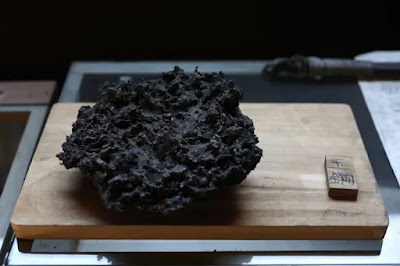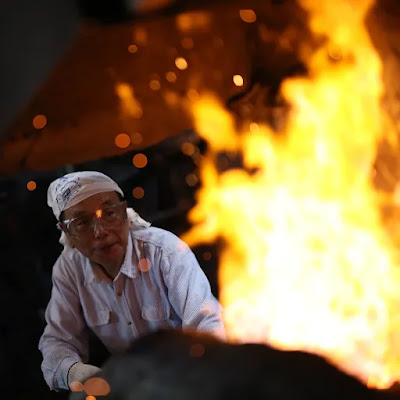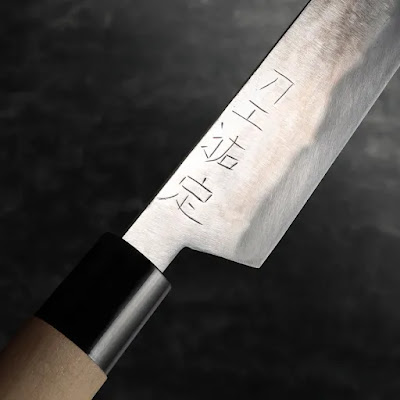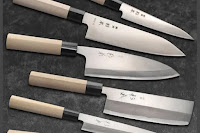However, beyond the flashy streets of the fast-paced capital is a culture that still values traditions and human connection. And traditional ways of hand-making goods are far from obsolete; they still produce the best that Japan has to offer.
Quality Over Quantity
While the Japanese makers of handmade goods can't pump out creations as fast as a modern factory, their talents, and ancestral techniques remain unmatched. A perfect example is Japanese kitchen knives, which have exploded in popularity over the last ten to fifteen years. In most professional kitchens worldwide, you'll find at least one or two chefs using Japanese knives. And home cooks are starting to catch on too. These knives are sharper, harder, lighter, and more stylish than anything coming off a factory conveyor belt.
 |
| Japanese Kitchen Knives |
And while many knife manufacturers are creating decent knives with nearly complete robotic automation - Japanese knives, laboriously and lovingly handmade, are considered amongst the highest-quality available. So, what's the big secret? How does a small chain of islands have such a strong knife culture in the first place, and how did it get a reputation for creating the best of the best?
Tamahagane and the Samurai
The Japanese have been creating iron and steel using a unique method for over a thousand years. Traditional tamahagane (literally meaning precious steel) was made using native iron-sand, which is of exceptionally high purity. This iron-sand was combined with charcoal and processed in a tatara clay forge, which can achieve extremely high temperatures. These two factors are, in part, the reason that the smiths were able to achieve high levels of hardness and sharpness in blades without cracking the metal during forging.
 |
| Tamahagane Steel |
And what were they using this steel for? Swords! It goes back to a deep history of samurai and their revered katanas. Feudal Japan was a fragmented society of battling warlords spanning about 400 years. As you might imagine, this fueled an industry of sword and weapon making. During this period, swordsmiths, such as the famous Masamune, became as legendary as the warriors wielding their creations. All sword-making began with creating the purist tamahagane possible.
Ironically, however, it was coming into the peaceful Edo Period that mastery of the tatara and smithing began to improve markedly. This time of prosperity and national unity decreased the demand for swords, so many swordsmiths refocused their skills on making tools and kitchen knives instead. Over the next three-hundred years or so, these families of once-swordsmiths became experts at kitchen cutlery, applying all the lessons they had learned making swords for the samurai.
 |
| Traditional Knife Making |
Modern Japanese Knives and Knockoffs
Fast-forward to today, steel and knife production is still a massive part of Japanese culture and Japan's economy. Some of the hardest, most expensive, and highest-quality knife and tool steels in the world are made in Japan. Japanese steel manufacturers are brewing up space-aged sounding steel alloys like ZDP-189, VG10, and R2 for kitchen knives. As a result, edge retention and sharpness levels have never been higher. In addition, the machinery available has made creating knives faster and easier than ever.
However, these innovations aren't what keep Japanese knives on top. On the contrary, because these advances make it easier to create knives, they arguably lower the required skills. And because of the rising popularity of Japanese knives, lazy companies from both inside and outside of Japan are taking advantage and flooding the market with poorly made products at marked-up prices. All they have to do is slap ‘Made in Japan’ and 'VG10' on the blade. This situation makes it more and more difficult for genuine sweat-and-blood handmade knives to find a place on the market, and sooner or later, this could hurt the reputation of Japan's quality knife industry.
Luckily, Japanese artisans are starting to fight back.
 |
| Japanese artisan at work |
Authentic Japanese Knives
The people over at Japanese Knife Co. recognized this disturbing trend and have begun working with local bladesmiths to source real, artisanal, handmade knives directly from Japan. And incredibly, they've even managed to get nationally celebrated swordsmith Ueta Osafune on board to create a unique tamahagane bunka knife. It's made from scratch the traditional way, hand hammered, sharpened, and polished. Of course, that isn't to say Japanese Knife Co.'s bladesmiths use zero technology, but you won't find an intern pushing a button on a computer and letting a robot spit out a flimsy knife.
 |
| Ueta Bunka Knife |
Their knife selection has a mixture of both modern stainless steel and super-hard old-school carbon steel. In addition, they offer traditional wooden handles with natural buffalo horn collars. They'll even engrave your name on the blade in Japanese. And while they do offer the popular standard designs like the gyuto and santoku, they also have a range of knives that are absolute classics, such as the deba and yanagiba. If you’re looking for the real deal, its Japanese Knife Co. These are the types of authentic knives that Japanese chefs buy.
 |
| Santoku Knife |
Wrap Up
Hopefully, this revival will continue in other traditional Japanese industries. Whenever you can, you should support authentic handmade goods. It's a great way of supporting local economies, growing human connections, and stopping cheap throwaway products from hurting the environment. Besides, you'll be thanking yourself later when you aren't re-buying the same half-baked product for the hundredth time when it breaks. If you want to bring yourself closer to Japan and Japanese culture, help the people who keep it alive.
Want to learn more about Japanese knife history and what’s going on in the world of handmade knives? There are loads of articles, tips, and tricks on Japanese Knife Co.’s blog.

